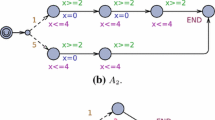Abstract
In this paper we propose a new way to represent P systems with active membranes based on Logic Programming techniques. This representation allows us to express the set of rules and the configuration of the P system in each step of the evolution as literals of an appropriate language of first order logic. We provide a Prolog program to simulate, the evolution of these P systems and present some auxiliary tools to simulate the evolution of a P system with active membranes using 2-division which solves the SAT problem following the techniques presented in Reference.10
Similar content being viewed by others
References
Arroyo, F., Luengo, C., Baranda, A. V. and De Mingo, L. F., “A Software Simulation of Transition P Systems in Haskell,”LNCS 2597, pp. 19–32, Springer-Verlag, Berlin, 2003.
Balbontín Noval, D., Pérez Jiménez, M. J. and Sancho Caparrini, F., “A MzScheme implementation of transition P systems,”LNCS 2597, pp. 58–73, Springer-Verlag, Berlin, 2003.
Bratko, I.,PROLOG Programming for Artificial Intelligence, Third edition, Addison-Wesley, 2001.
Ciobanu, G. and Paraschiv, D., “Membrane softwre. A P system simulator,”Fundamenta Informaticae, 49, 1–3, pp. 61–66, 2002.
Pâun, G., “Computing with membranes,”Journal of Computer and System Sciences, 61, 1, pp. 108–143, 2000.
Pâun, G.,Membrane Computing. An Introduction, Springer-Verlag, Berlin, 2002.
Pâun, G. and Rozenberg, G., “A Guide to Membrane, Computing,”Theoretical Computer Sciences, 287, pp. 73–100, 2002.
Pâun, G., Rozenberg, G. and Salomaa, A., “Membrane Computing with External Output,”Fundamenta Informaticae, 41, 3, pp. 313–340, 2000.
Pérez Jiménez, M. J., Romero-Jiménez, A. and Sancho-Caparrini, F.,Teoría de la Complejidad en modelos de computación celular con membranas, Editorial Kronos, Sevilla, 2002.
Pérez-Jiménez, M. J., Romero-Jiménez, A. and Sancho-Caparrini, F, “The Polynomial Complexity Class in P Systems using Membrane Division,” Submitted.
Suzuki, Y. and Tanaka, H., “On a LISP Implementation of a Class of P Systems,”Romanian J. of Information Science and Technology, 3, 2, pp. 173–186, 2000.
The P Systems Web Page: http://psystems.disco.unimib.it/
Logic Programming: http://www.afm.sbu.ac.uk/logic-prog/
Author information
Authors and Affiliations
Additional information
Andrés Cordón-Franco: He is a member of the Department of Computer Science and Artificial Intelligence at the University of Sevilla (Spain). He is also a member of the research group on Natural Computing of the University of Seville. His research interest includes Mathematical Logic, Logic in Computer Science, and Membrane Computing, both from a theoretical and from a practical (software implementation) point of view.
Miguel A. Gutiérrez-Naranjo: He is an assistant professor in the Computer Science and Artificial Intelligence Department at University of Sevilla, Spain. He is also a member of the Research Group on Natural Computing of the University of Seville. His research interest includes Machine Learning, Logic Programming and Membrane Computing, both from a theoretical and a practical point of view.
Mario J. Pérez-Jiménez, Ph.D.: He is professor of Department of Computer Science and Artificial Intelligence at University of Seville, where he is the head of the Group of Research on Natural Computing, He has published 8 books of Mathematics and Computation, and more than 90 scientific articles in prestigious scientific journals. He is member of European Molecular Computing Consortium.
Fernando Sancho-Caparrini: He is a member of the Department of Computer Science and Artificial Intelligence at the University of Sevilla (Spain). He is also a member of the research group on Natural Computing of the University of Seville. His research interest includes Complex Systems, DNA Computing, Logic in Computer Science, and Membrane Computing, both from a theoretical and from a practical point of view.
About this article
Cite this article
Cordón-Franco, A., Gutiérrez-Naranjo, M.A., Pérez-Jiménez, M.J. et al. A Prolog simulator for deterministic P systems with active membranes. New Gener Comput 22, 349–363 (2004). https://doi.org/10.1007/BF03037286
Received:
Revised:
Issue Date:
DOI: https://doi.org/10.1007/BF03037286




